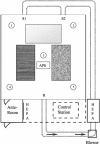Determination of the efficacy of two building decontamination strategies by surface sampling with culture and quantitative PCR analysis
- PMID: 15294810
- PMCID: PMC492428
- DOI: 10.1128/AEM.70.8.4740-4747.2004
Determination of the efficacy of two building decontamination strategies by surface sampling with culture and quantitative PCR analysis
Abstract
The efficacy of currently available decontamination strategies for the treatment of indoor furnishings contaminated with bioterrorism agents is poorly understood. Efficacy testing of decontamination products in a controlled environment is needed to ensure that effective methods are used to decontaminate domestic and workplace settings. An experimental room supplied with materials used in office furnishings (i.e., wood laminate, painted metal, and vinyl tile) was used with controlled dry aerosol releases of endospores of Bacillus atrophaeus ("Bacillus subtilis subsp. niger," also referred to as BG), a Bacillus anthracis surrogate. Studies were performed using two test products, a foam decontaminant and chlorine dioxide gas. Surface samples were collected pre- and posttreatment with three sampling methods and analyzed by culture and quantitative PCR (QPCR). Additional aerosol releases with environmental background present on the surface materials were also conducted to determine if there was any interference with decontamination or sample analysis. Culture results indicated that 10(5) to 10(6) CFU per sample were present on surfaces before decontamination. After decontamination with the foam, no culturable B. atrophaeus spores were detected. After decontamination with chlorine dioxide gas, no culturable B. atrophaeus was detected in 24 of 27 samples (89%). However, QPCR analysis showed that B. atrophaeus DNA was still present after decontamination with both methods. Environmental background material had no apparent effect on decontamination, but inhibition of the QPCR assay was observed. These results demonstrate the effectiveness of two decontamination methods and illustrate the utility of surface sampling and QPCR analysis for the evaluation of decontamination strategies.
Figures





References
-
- American Conference of Governmental Industrial Hygienists. 1999. Bioaerosols: assessment and control. American Conference of Government Industrial Hygienists, Cincinnati, Ohio.
-
- Buttner, M. P., P. Cruz-Perez, L. D. Stetzenbach, P. J. Garrett, and A. E. Luedtke. 2002. Measurement of airborne fungal spore dispersal from three types of flooring materials. Aerobiologia 18:1-11.
-
- Buttner, M. P., K. Willeke, and S. Grinshpun. 2002. Sampling and analysis of airborne microorganisms, p. 814-826. In C. J. Hurst, G. Knudsen, M. McInerney, M. V. Walter, and L. D. Stetzenbach (ed.), Manual of environmental microbiology, 2nd ed. ASM Press, Washington, D.C.
Publication types
MeSH terms
Substances
LinkOut - more resources
Full Text Sources
Other Literature Sources

